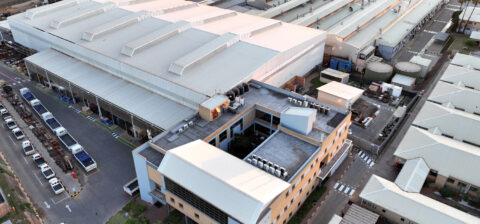SA Mining
2020 The Year That Was
By: Ogi Williams, associate director at In On Africa
The onset of the COVID-19 pandemic has reshaped the face of the global economy, permanently impacting every facet of human interaction.
Social distancing restrictions remain in a number of countries, with safety rules on wearing protective attire being implemented stringently and many still holding travel bans in place. As with other industries, the global mining sector was severely impacted by COVID-19 restrictions with the operations of companies such as Alta Zinc, Anglo American and Rio Tinto among others grinding to a halt in early March across key production and processing markets such as Italy, Mongolia, Peru and South Africa.
The impact of this move has sent a shockwave through the industry, with the impact being felt most by labour with many miners experiencing retrenchments or going on unpaid leave.
With the pressing need to stem the tide in global COVID-19 infections, while also avoiding complete financial implosion, the industry has had to place impetus on fast-tracking automation and digitalisation in maintaining open operations.
Though negative in the eyes of some, the moves will be necessary going forward in keeping the industry operating. What will be important is maintaining open channels of communication and providing community support as the transition unfolds.
The main impacts of COVID-19 on the mining industry
The first few months of imposed lockdown restrictions had the biggest effect on the global mining sector. Imposed movement restrictions put a stop to mining operations across the world over the period March-May, and resulted in a ripple effect throughout the entire mining supply chain.
Everyone including producers, processors, refiners, transporters, traders and end-users were affected. Subdued economic activity led to a drop in demand for minerals and metals which placed stakeholders across the value chain in a precarious position.
Mining companies in particular were losing income while increasing expenditure to keep operations afloat until restrictions eased. Certain sectors, like platinum group metals, were more affected than others given the decreased demand for electronic products. Others like gold were stifled across the board and at a time when demand was on the rise.
By virtue of geographic separation, some producers were able to keep operations going, but the fragmentation of supply routes more generally drove prices higher, which in turn pulled demand down creating a circular downward spiral.
For producers like South Africa the lockdown period and the broader drop in demand had a considerably more negative effect given the large labour force which is employed by the mining industry. Even with the sector reopening in early May, the gradual spread of infections resulted in a number of operations being shut down for days at a time, disrupting both production flow and output. By July, this combination of factors had resulted in the Minerals Council South Africa projecting a 15% to 25% output drop for the year compared to 2019.
This comes at a time when the industry has struggled to attract investment for a number of years given infrastructure constraints such as unstable electricity access, poorly developed rail and road routes, an uncertain legislative environment and a persistently high incidence of corruption.
In addressing the short-term challenges, industry stakeholders should continue to communicate and collaborate.
At the onset of the pandemic, a number of global mining companies began to open channels of communication between themselves in providing the necessary support to communities where they operate.
This was evidenced in the Australian market with the Minerals Council of Australia hosting working group meetings with senior executives to find solutions to alleviate the economic and social impact of the virus.
Funds and aid poured in from global miners into key markets like Australia as well as others where they have operations. Diamond miner De Beers contributed $2.5-million to providing support to Botswana and Namibia, while Barrick Gold donated between $1.5m and $1.7m respectively to Congolese and Tanzanian COVID-19 support programmes, and a further half a million to the Zambian government. Some governments have also come to the table in offering support to mining operators including waiving mineral exploration costs (Greenland), deferring exploration costs (Australia), and extending wage subsidies (Canada), among others.
The South African mining industry too implemented a number of support measures, including the donation of personal protective equipment to hospitals and clinics worth millions. Communication channels between government and business representative organisations such as the Minerals Council have also remained open, which has alleviated further pressure on the already strained sector. Initiatives such as these need to continue going forward as the industry is set to undergo change in combating both the spread of COVID-19 as well as threats from other producer markets that are better able to combat spreading infections among their employees.
To weather the long-term risks, automating operations and shifting to digital will be necessary.
A prominent challenge which the South African mining sector faces related to any future strategies of combating COVID-19 is the seasonality of labour and how it moves both inside the country’s borders as well as across them. Interprovincial and cross-border travel of miners to and from Mozambique poses a considerable danger to controlling the spread of COVID-19 in the region.
South Africa’s weaker preparedness to automate also places it at a greater risk of losing market share to others who are better positioned – the Syama Gold Mine in Mali for example is fully automated and can maintain operational output for the one commodity that remains high in demand despite stifled global economic activity. These considerations need to be taken into account in fast-tracking automation to combat lapses of activity caused by the spread of the pandemic. Use of drones in monitoring operations alongside self-driving trucks will further mitigate potential risks of transmission while enhancing efficiency in operations.
As the operational side of the industry has looked to adapt, other segments further up the chain such as auctions, conferences, and tender processes have moved online in doing the same. Metal traders and other companies including Gem Diamonds and Alrosa have embraced digital platforms in hosting tenders, while the World Federation of Diamond Bourses has developed a cross-bourse trading platform in allowing investors to continue trading despite movement and other restrictions. Implementing such structures will enhance the competitiveness of mining companies while also allowing them to keep processes moving.
The way forward
The current motions highlight how the supply line at the end of the value chain has started to adjust to the new normal, which will in turn necessitate the same for the start of the value chain. Those who have begun to shift towards fully or partially automated production will also be more competitive, both from an interruption-incidence point of view given rising infections, as well as from a cost-competitive perspective of production efficiency.
As a result, both automation and digitalisation have to form part of future development strategies and policy updates in keeping up with global alignments to working around COVID-19 risks – retraining and reskilling staff too will need to be included within working models to automate and digitalise.
As also noted, in the case of South Africa there is a need for sizeable infrastructure investment to assist in facilitating the future development of the industry, while also strengthening investor confidence and improving the business environment in overcoming the challenges that COVID-19 has brought, not only now but also for the indefinite future.





